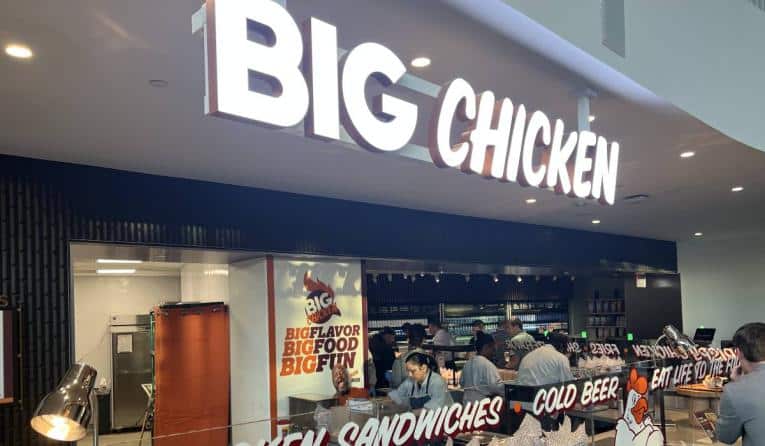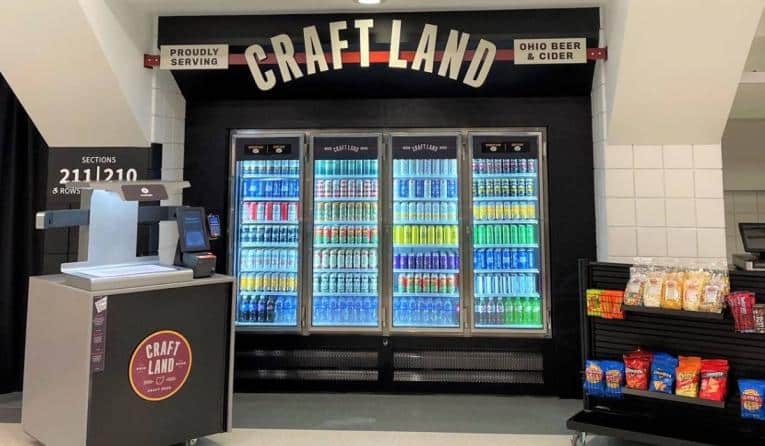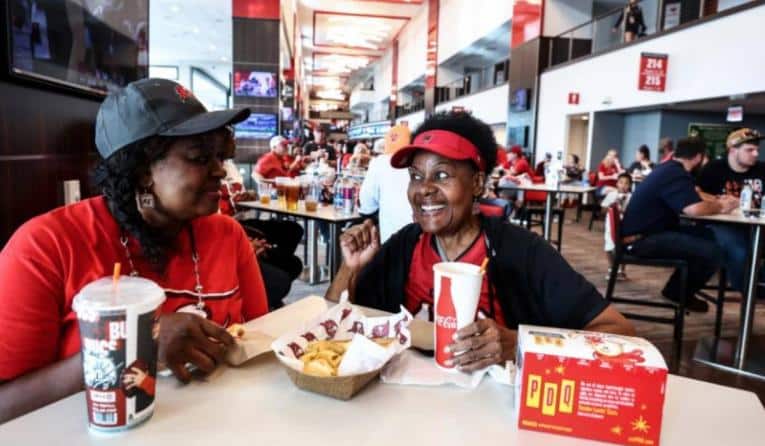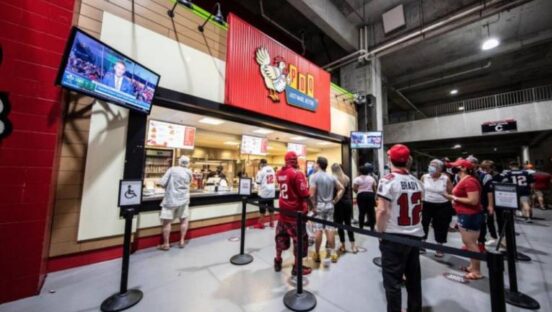With Shaquille O’Neal as a founder and a lineup of handheld menu items, Big Chicken is a natural fit for concessions. Founded five years ago by the NBA Hall of Famer, the fast-casual chain is rapidly expanding its footprint in stadiums and arenas.
The brand opened its first concession stand in Seattle’s Climate Pledge Arena in late 2021, and by early 2023, it had surpassed 100,000 sandwiches sold in the venue.
“I don’t think anyone could have imagined how successful we would be in these arenas,” CEO Josh Halpern says. “Now, we’re entering arenas constantly, and it’s a major part of our strategy.”
The Climate Pledge Arena outlet was the first fast-casual restaurant in the country to feature Amazon’s Just Walk Out Technology and Amazon One, enabling guests to forgo the long lines that are a perennial part of the game day experience. The system is similar to Amazon Go, the tech giant’s cashierless convenience store, but instead of packaged snacks and drinks, fans are returning to their seats with a Shaq-approved crispy chicken sandwich.
Just Walk Out lets guests insert their credit card at the location’s entry gate or hover their palm over an Amazon One device before entering. Leveraging computer vision, sensor fusion, and deep learning—the same technologies that power self-driving cars—it determines what items they take from Big Chicken, and the credit card they inserted or linked to their Amazon One ID is charged for the purchase.
“The reason for Just Walk Out is fairly simple,” Halpern says. “Food isn’t the main draw when you go to a sporting event or a concert. It’s a great part of the experience, but the draw is the game or the concert itself. So, the question becomes, how can we reduce friction? How can we get the best food in the shortest amount of time possible, so fans can get back to their seats and watch the game?”
The location is operated by Delaware North, which manages hospitality services at nearly 50 sports and entertainment venues worldwide. It’s just one example of the company’s focus on tech-driven frictionless fan experiences coming out of the pandemic.
Jamie Obletz, president of Delaware North Sportservice, says concessions at stadiums and arenas are evolving faster than they ever have before.
“You had a period of 12-18 months where everything went dark,” he says. “When venues did start reopening, it was initially to no fans or with restricted capacities. It was tough going, but it gave us the opportunity to think about the business at a deeper level and dream of what it could be when we reopened. Even more importantly than giving us the time to think that through, it gave us the change management inertia we needed.”
Conversations around innovation and new service models were happening before venues went dark, but Obletz says that 12–18 months period was the catalyst Delaware North needed to “supercharge” those efforts. One of the biggest changes was taking the business cashless, a move he says simplified operations, improved labor efficiency, increased speed of service, and expanded the size of the average transaction.
“As we’ve implemented a cashless footprint, we’ve integrated new ways of serving guests,” Obletz says. “We’ve transitioned a large part of our business away from traditional belly-up stands, and we’ve gone to marketplace concepts, where you can enter a market and have more free reign over what you’re picking. Then, when you exit that market, we’ve got everything from self-checkout to autonomous checkout, to digital camera-based checkout.”

Aramark also is embracing digital innovation. The company’s data science and design teams were studying technology and consumer interest trends like touchless and frictionless vendor experiences before the pandemic. By the time reopening began, it had developed a slew of innovations that could limit close contact and reduce congestion at the more than 200 stadiums and arenas it serves.
“Our clients were looking for things that were more frictionless coming out of COVID,” says Alicia Woznicki, vice president of design and innovation at Aramark. “We have the solutions to do that, and they also happen to really enhance the fan experience, too.”
Already commonplace in the greater retail market, self-order kiosks have emerged as a key area of focus.
“It was something that we weren’t getting a lot of adoption from pre-pandemic,” Woznicki says. “We’d have a kiosk location, and people would choose to go to the next section over.”
She says the biggest change in consumer behavior coming out of COVID was the considerable uptick in guests using kiosks. Along with speeding up service and freeing up employees to focus on other tasks, data from Aramark show that self-ordering systems lead to an 18 percent increase in sales.
Mobile ordering was another area of focus, but Woznicki says the company is still seeing limited consumer adoption on that front.
“Despite a lot of our partners and people in the industry thinking this was going to be the immediate change when we opened back up, we’re not necessarily seeing the consumer buy-in,” she says. “It’s one of those things that can get lost from a messaging perspective and the hustle and bustle of a stadium. I still think it’s coming, just not at the pace we anticipated.”
Aramark encourages digital ordering by pairing the systems with highly desirable menu items. It also is adding layers of convenience with concepts designed around the technologies. As an example, a Virtual Food Hall concept enables fans to purchase items from multiple locations throughout the building. Instead of waiting in four or five lines, they can go to a single pickup window to grab the entire order. A concept called Hall of Favs offers an even more consolidated version of that idea. It features the most popular concession items in one location, available via kiosk or mobile ordering.
“It’s almost like a ghost kitchen,” Woznicki says. “Instead of doing just one concept, you’re doing all of the most popular items throughout the entire building in a single high-powered kitchen. We’ve also done a lot around alcoholic beverages because that makes up such a huge portion of our sales across our portfolio.”
A Beer Express concept lets fans order and pay from their phone, then pick up their beer from one of more than a dozen locations around the stadium after showing their ID.
“What we realized when we started saying, ‘Hey, you don’t have to check out, you can go right back to the game,’ is that there was one last piece of friction around checking IDs manually,” Woznicki says. “Everything is going smoothly, and then you’ve got this one bottleneck. So, we started thinking about how we can automate that process as well.”

Along with speeding up service and freeing up employees to focus on other tasks, data from Aramark show that self-ordering systems lead to an 18 percent increase in sales.
The answer came in the form of an upgraded beer-purchasing program that uses facial authentication technology to speed up the age verification process. Fans still order and pay through their phones, but when they go to the beer stand, they scan their face for age and order verification.
Delaware North already is tapping into biometric technology with Amazon One devices. Guests who are registered with the system can pay with the swipe of a hand. Obletz sees similar opportunities to automate age verification for guests purchasing alcoholic beverages, but the possibilities don’t end there. In the future, he predicts stadiums and arenas will dedicate large portions of the venue, if not the entirety of the venue, to a completely seamless experience, where guests don’t even need to use their credit cards.
“Guest expectations are rising very rapidly, and our challenge now is to continue evolving the business in lockstep with those changing expectations,” he says.
Another task will be meeting heightened expectations around food and beverage offerings.
“This trend was very much underway pre-COVID, and it accelerated with the pandemic,” Obletz says. “You’re seeing two fronts on the culinary side. Expectations on quality and variety have increased, and expectations around local and offerings that are tied to the external marketplace have increased.”
Woznicki says concessions have been evolving beyond the typical stadium fare for years, and that won’t stop anytime soon. Aramark is tapping into the trend through LTO programs and partnerships with local providers.
This year, the company introduced a slew of collaborations across its MLB stadiums. A Taste of Queens concept in New York’s Citi Field features a revolving lineup of local eateries. Similarly, a Launch Test Kitchen concept lowers the cost of entry for up-and-coming brands, giving innovative newcomers the chance to gain exposure in stadiums without setting up a permanent location.
Aramark also is capitalizing on social media trends with successful LTO programs. Last year, it launched a Dare to Pair program that tasked chefs with developing their unique offerings featuring uncommon flavor combinations.
“We went viral with a Pulled Pork and Reese’s Peanut Butter Cup sandwich in Kansas City,” she says. “Even though it was a little out there, it really resonated with people and ended up becoming one of our highest-selling LTO programs. It helped us realize how the expectation around what used to be hot dogs, popcorns, and nachos is now so much more. People are even willing to experiment with completely out-of-the-box things.”
Big Chicken has catered to hometown fans with locally inspired menu items. Earlier this year it entered Busch Stadium in St. Louis, home to baseball’s Cardinals, where it teamed up with a cult-favorite donut shop for a chicken sandwich served on a red-dyed maple bacon donut.

PDQ, a Florida-based fast-casual chicken chain, has concession stands throughout the Southeast, including in its home market of Tampa. Jeffrey Kamis, vice president of marketing and public relations, says the localized nature of those partnerships offers something that can’t be captured with traditional marketing collateral.
“The first PDQ was here in Tampa, and we’re the official chicken tender of the Tampa Bay Buccaneers,” he says. “That connection means something to people, especially here in our home market, where people are fans of the local teams.”
For fans that aren’t already familiar with the brand, the concession stands offer an unparalleled opportunity to convert stadium-goers into loyal customers. To further unlock that opportunity, the company has worked with its partners to streamline the concession stand menu and eliminate items that aren’t resonating in the channel. Kamis says the smaller menu has improved speed of service and helped ensure the outlets are delivering restaurant-quality food.
“Regardless of who’s serving the food in the concession stand, it’s our name on the wall there. So from our perspective, it’s really important that the brand is represented the right way,” he says. “Our chicken is hand-breaded and cooked fresh right at the stands, so we do training with staff at all the venues several times a year to make sure they’re up to date on all the procedures.”
Big Chicken had to adjust its standard operating procedures in concession stands to handle the massive influx of volume. A single stand may sell around 500 sandwiches in 30 minutes during a concert, or 1,000 sandwiches in 90 minutes during a sporting event.
“In brick-and-mortar restaurants, we’re dropping the chicken made-to-order, but here, we’re always dripping chicken and then dressing it made-to-order,” Halpern says. “If you’re going to order an Uncle Jerome–our Nashville hot sandwich–we’re going to quickly dunk it in the Nashville hot oil, add the toppings, and out it goes. But the chicken was already in motion before you ordered.”
For restaurant brands that make an impression in the stadium, he says the benefits of concessions extend far beyond the revenue generated on game day.
“In the beginning, we were the No. 1 concession stand in the Climate Pledge Arena, and we didn’t have any brick-and-mortars in that market,” he says. “I used to joke with Shaquille that getting into stadiums early was both a blessing and a curse because if people loved our food, the closest restaurant was about 1,000 miles away.”
When the brand opened its first location in Seattle, it quickly became the No. 1 store systemwide.
“We had massive built-in demand the minute we opened our doors,” Halpern says. “Now, if we know we’re going into a stadium or arena, the question becomes, how do we get a franchisee there?
“If we’re going to generate all of this demand, we’d be crazy not to ensure that fans are able to get our food when they leave the stadium, too.”









